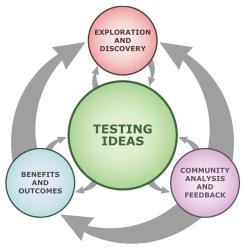Source Institutions
Source Institutions
Add to list Go to activity
Activity link broken? See if it's at the internet archive

In this multi-station lab, learners conduct a series of experiments to explore the processes and effects of weathering and erosion. Using the results from these explorations, learners design and conduct an experiment comparing the rate of erosion in different biomes. Use this activity to teach weathering and erosion, and also to illustrate how scientists often use the results of one experiment to inspire another. This activity is intended to be conducted over multiple meetings.
- 30 to 45 minutes
- 1 to 7 days
- $5 - $10 per group of students
- Ages 8 - 14
- Activity, Experiment/Lab Activity, Lesson/Lesson Plan
- English
Quick Guide
Materials List (per group of students)
- 1 Small pan (an 8x8 baking dish works well)
- 2 Large pans (turkey roasting pans or large shallow plastic tubs work well)
- Thick layer of clay (about the length and width of a brick)
- Brick (1 brick for every 2 pairs of students)
- Small plastic bowls (1 per student pair)
- Gravel (2 handfuls per student pair)
- Water
- Sand (enough to fill the shallow pans for each student pair, to make a small "beach" on one side of the large pan, and another handful for each pair)
- Dirt (enough to fill the large pans)
- 2-3 textbooks
- Sandpaper (a 50 grain or similarly coarse sandpaper will work best for this) (1 small piece per student pair)
- Rough samples of a soft stone such as calcite, limestone, dolomite, fluorite, rhyolite or similar stone with a hardness of about 3-4 on the Mohs hardness scale (at least 2 different samples for each student pair)
- Sugar cubes (approximately 5-7 per student pair)
- One baby food jar or canning jar with lid
- Super-fine iron wool (1 clump per student pair) (this can be found in paint or hardware stores; the steel wool you find in grocery stores is usually stainless steel and will resist rust)
- Tape and 3 markers to label beakers with
- 2 pieces of chalk per student pair
- Mortar and pestle
- Vinegar (about ¾-1 cup per student pair)
- Small beakers (three per student pair + 3 additional beakers)
- Two small beakers with a pouring lip/spout
- 2 Alka-Seltzer or other brand antacid tablets per student pair
- Timer or clock
- 2 copper pennies (before the year 1981 works the best) per student pair
- 1 tsp. of salt per student pair
- One clear plastic cup per student pair
- Teaspoon
- Garbage bags, buckets, large bowls, or other place for students to dispose of wet sand, dirt, gravel and rocks at some lab stations
- Lab Station Instructions
- Teacher Station List
- Student Lab Notebooks
Subjects
-
Earth and Space Science
-
Earth Processes
- Geochemical Cycles
- Weather and Climate
-
Earth Structure
- Rocks and Minerals
- Oceans and Water
-
Earth's History
- Geologic Time
-
Earth Processes
-
The Nature of Science
-
The Scientific Process
- Asking Questions
- Conducting Investigations
- Gathering Data
-
The Scientific Process
Informal Categories
- Model Building
Audience
To use this activity, learners need to:
- see
- read
- touch
Learning styles supported:
- Involves hands-on or lab activities
Other
Components that are part of this resource:
- Teacher Station List
- Lab Station Instructions
- Related Lesson--Dust in the Wind; Chemicals in the Water
This resource is part of:
Access Rights:
- Free access
By:
- Whitfield, Lise
Rights:
- All rights reserved, The University of California Museum of Paleontology, Berkeley, and The Regents of the University of California, 2010
Funding Source:
- National Science Foundation, EAR-0624436
